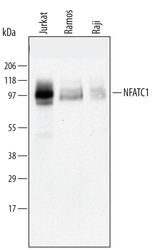Antibody data
- Antibody Data
- Antigen structure
- References [0]
- Comments [0]
- Validations
- Western blot [2]
Submit
Validation data
Reference
Comment
Report error
- Product number
- AF5640 - Provider product page

- Provider
- R&D Systems
- Product name
- Human NFATC1 Antibody
- Antibody type
- Polyclonal
- Description
- Immunogen affinity purified. Detects human NFATC1 in Western blots.
- Reactivity
- Human
- Host
- Goat
- Conjugate
- Unconjugated
- Antigen sequence
O95644- Isotype
- IgG
- Vial size
- 100 ug
- Concentration
- LYOPH
- Storage
- Use a manual defrost freezer and avoid repeated freeze-thaw cycles. 12 months from date of receipt, -20 to -70 °C as supplied. 1 month, 2 to 8 °C under sterile conditions after reconstitution. 6 months, -20 to -70 °C under sterile conditions after reconstitution.
No comments: Submit comment
Supportive validation
- Submitted by
- R&D Systems (provider)
- Main image

- Experimental details
- Detection of Human NFATC1 by Western Blot. Western blot shows lysates of Jurkat human acute T cell leukemia cell line, Ramos human Burkitt's lymphoma cell line, and Raji human Burkitt's lymphoma cell line. PVDF membrane was probed with 1 µg/mL of Goat Anti-Human NFATC1 Antigen Affinity-purified Polyclonal Antibody (Catalog # AF5640) followed by HRP-conjugated Anti-Goat IgG Secondary Antibody (Catalog # HAF109). A specific band was detected for NFATC1 at approximately 110 - 120 kDa (as indicated). This experiment was conducted under reducing conditions and using Immunoblot Buffer Group 1.
- Submitted by
- R&D Systems (provider)
- Main image

- Experimental details
- Detection of Human NFATC1 by Simple WesternTM. Simple Western lane view shows lysates of Jurkat human acute T cell leukemia cell line, loaded at 0.2 mg/mL. A specific band was detected for NFATC1 at approximately 124 kDa (as indicated) using 10 µg/mL of Goat Anti-Human NFATC1 Antigen Affinity-purified Polyclonal Antibody (Catalog # AF5640) followed by 1:50 dilution of HRP-conjugated Anti-Goat IgG Secondary Antibody (Catalog # HAF109). This experiment was conducted under reducing conditions and using the 12-230 kDa separation system.
 Explore
Explore Validate
Validate Learn
Learn Western blot
Western blot